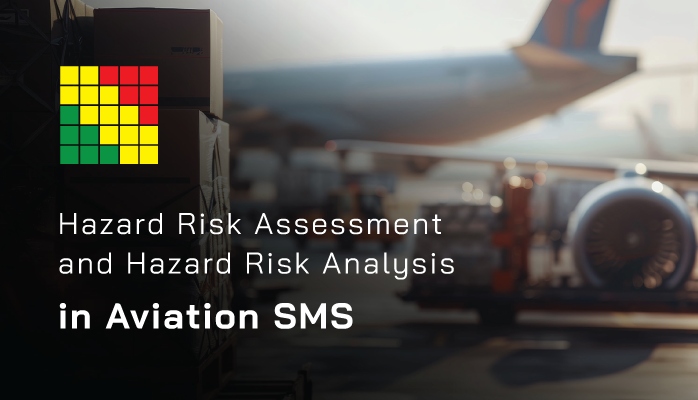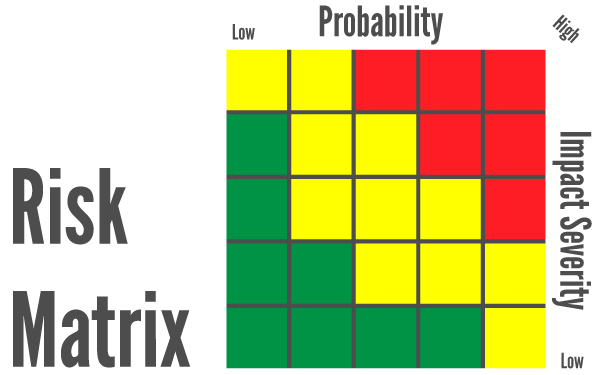Why It’s Important to Understand the Difference Between Assessment and Analysis

In aviation safety management systems (SMS), one of the main activities that senior managers and safety teams will undertake will be to
- identify hazards;
- evaluate risk associated with these hazards; and
- determine whether existing risk controls are adequate.
Hazard Risk Assessment and Hazard Risk Analysis are central components of the highly inter-related Safety Risk Management (SRM) and Safety Assurance (SA) processes.
Just as having a correct understanding of various risk management definitions, understanding the difference between analysis and assessment is important to ensure:
- Accuracy of decisions;
- Efficient risk management actions; and
- Proper workflow as hazards are reviewed, treated, and monitored in the aviation SMS.
Related Aviation SMS Hazard and Risk Articles
- Difference Between Hazards, Risks & Control Measures in Aviation SMS
- 5 Tips Reviewing Hazards, Risks & Controls in Aviation SMS - With Examples
- How to Identify Hazards and Assess Risks in Aviation SMS - With Free Resources
What Is Your Process for Hazard Risk Analysis and Assessment?
SMS regulatory compliance guidelines recommend a particular order for risk analysis and assessment for good reason. There is no reason for you to recreate the wheel when developing your SMS risk management processes. The processes outlined by ICAO and regulatory agencies are logical, and best of all, easy to understand. In this case, performing an initial hazard risk assessment BEFORE the hazard risk analysis activity is sort of like trying to cook before lighting the fire.
Understanding the differences between risk assessment and risk analysis is an essential part of getting the risk management workflow right, and knowing when to perform required risk management activities in which order. Analyzing and assessing activities are related, but they are not the same thing.
Here are the differences between hazard risk assessment and hazard risk analysis.
What Hazard Risk Analysis Is

The most important thing to understand about hazard risk analysis is that it is reductive in the sense that it involves:
- Identifying the safety issue and examining it;
- Investigating and interpreting the results;
- Breaking a complex situation into simple parts; and
- Understanding how those elementary parts of the situation fit together to produce the undesirable situation.
When conducting the risk analysis, safety personnel should consider the:
- safety criticality of the affected processes related to the safety issue;
- results from previously documented risk analyses and assessments from similar types of safety issues, whether they are audit findings or issues coming from the safety reporting system;
- implemented and scheduled safety risk controls.
The purpose of the hazard risk analysis is to identify:
- operational safety deficiencies;
- areas of real or potential regulatory compliance;
- internal processes and procedures that have not been followed or need additional monitoring; and
- operational processes that could be improved.
Related Aviation SMS Risk Analysis Articles
- How to Perform Risk Analysis in Aviation SMS
- 5 Outcomes for Risk Analysis Activities in Aviation SMS
- Everything You Need to Know About Risk Analysis in Aviation SMS
Hazard Risk Analysis Outcomes
Classifying a reported safety issue during the risk management process is a perfect example of outcomes that result from risk analysis. The process of classifying reported safety issues and audit findings is synonymous with documenting the interpretation of the risk analysis results.
Once a safety concern has multiple, descriptive classifications associated with it, one can understand the simple, basic elements that either contributed to or will contribute to, the hazard manifesting itself and exposing the organization to unwanted risk. Such classifications are common:
- The type of safety issue, which answers the question: “What is this issue really about?”;
- The central hazard, which answers the question: “What is the primary danger in this situation?”;
- The root causes, which answers the question, “What are the mechanisms that will allow or have already allowed the danger to arise?”;
- The Human Factors, which answers the question, “Which specific human behaviors contributed to the issue?”;
- And so on.
Classification Schemes Facilitate Risk Analysis Activities
You can realistically classify safety concerns using many other dimensions or taxonomies, such as
- policies/procedures;
- locations where specific hazards exist;
- job tasks, etc.
Classification schemes (taxonomies) are useful to describe safety concerns, but how is the actual analysis performed? There are many accepted methodologies for conducting a hazard risk analysis, but some of the most common are:
- 5-Whys analysis;
- Bowtie analysis;
- Decision Trees; and
- (new and less common) SMS Shortfall Analysis.
Related Articles on Aviation SMS Data Classification Management
- How to Set Up Classifications in Aviation SMS Implementations
- How to Organize Data for Good Data Analysis in Aviation SMS [Best Practices]
- Best Practices for Categorizing Your Data in Aviation SMS
What Hazard Risk Assessment Is
Hazard risk assessment is something that happens after a hazard risk analysis. After all, one has to know the details of any problem before one can determine operational risk. Hazard risk assessments in your aviation SMS' risk management processes involve:
- Measuring the value of something (FAA order 8040.4A) – usually either safety performance or safety exposure;
- Quantifying the value;
- Documenting the value; and
- Using the assessed value to inform what kind of decision is to make.
The reason that hazard risk assessment happens after analysis is that the findings from the analysis will heavily influence the value of the risk assessment. In other words, risk assessments without analysis is an assessment that is not supported by anything, no data, no historical review, simply just a hunch or a wild guess.
Risk Matrix Remains Hallmark of Hazard Risk Assessments

Risk assessments in aviation SMS are facilitated with the use of a risk matrix. In your risk matrix, various risk assessment values should have clearly defined boundaries and definitions. For example, in the case of a risk matrix:
- It will have various qualifiers for each level of severity; and
- It will have various qualifiers for each level of probability or likelihood that the organization will be exposed to the risk.
By qualifiers, we are talking about defining things like:
- Minimum monetary damages for each level of risk;
- Damage to person(s) for each level of risk;
- Effect on mission for each level of risk; and
- Expected probability of recurrence (low, possible, likely).
Related Articles on Conducting Risk Assessments in Aviation SMS
- 4 Pillars | What Is Risk Assessment in Aviation SMS
- What Is a Risk Matrix and Risk Assessment in Aviation SMS
- 5 Questions to Ask Before Making Risk Assessment
How Risk Analysis and Risk Assessment Are Related
As implied, the relation between risk analysis and risk assessment is:
- Risk analysis provides the data on which risk assessments are based;
- Risk assessments create a value for the entire body of analysis data; and
- Assessments quantify the qualitative analysis findings.
Long story short, the risk assessment summarizes the analysis and facilitates the communication of risk among risk management professionals.
Workflow for Risk Analysis and Risk Assessment
The primary workflow usually looks something like this:
- An employee identifies a hazard or an audit finding has been submitted;
- A safety issue is reported and safety teams are notified;
- The issue is investigated with various risk management tools such as bowtie, fishbone diagrams, custom investigatory processes, etc.;
- Investigation findings inform which classifications adequately describe the underlying issue;
- Based on classifications and other analysis data, a risk matrix is used to assign a valuation of likelihood/severity to the issue; and
- Based on this assessment, the safety concern is prioritized in the organization's risk management queue.
Final Thoughts on Risk Analysis and Risk Assessments
The value risk management professionals receive from the risk assessment is always dependent on the risk analysis. When safety managers haphazardly rush through the risk analysis activities, the accountable executive and senior managers may be making decisions based not on facts, but on imperfect assumptions.
A major challenge for performing risk analysis activities is reviewing historical data. You are trying to determine:
- Are we complying with regulatory guidelines?
- How often does this type of event affect our operations?
- What did we do in the past to treat the risk?
- Were the risk controls effective? If not, why?
- Who was involved in treating these past safety issues?
- How can we improve our processes, so this doesn't occur again?
These are all valid questions to ask when conducting the risk analysis. A challenge many safety professionals face every day is that they don't have an effective data management strategy to facilitate responsive risk analysis activities. An aviation SMS database allows managers to more quickly evaluate historical safety issues and to determine which risk controls are not performing as designed.
Does this sound like your aviation SMS?
Having all relevant SMS data in one centralized SMS database has many advantages. These advantages go well beyond data analysis. If you are having trouble reviewing historical data during your data analysis activities, what will you do when it comes to practicing predictive risk management activities?
The longer you wait to start managing your aviation SMS data in an organized SMS database, the more opportunities will slip by.
To learn how your organization can benefit from an SMS database, please watch these short demo videos.
Last updated in April 2025.








